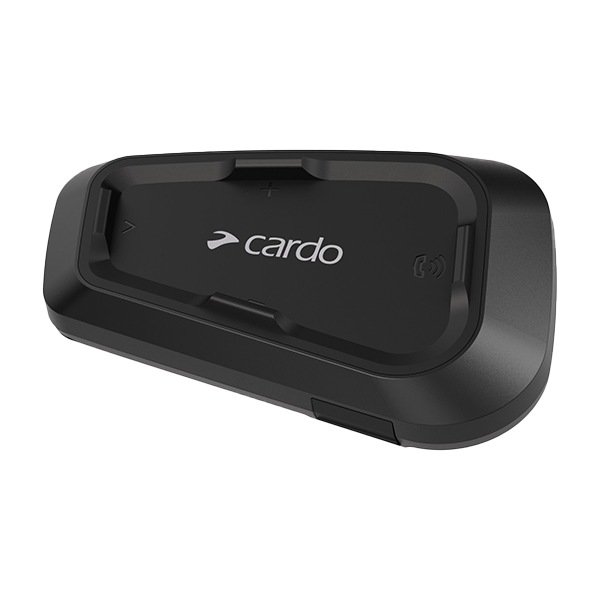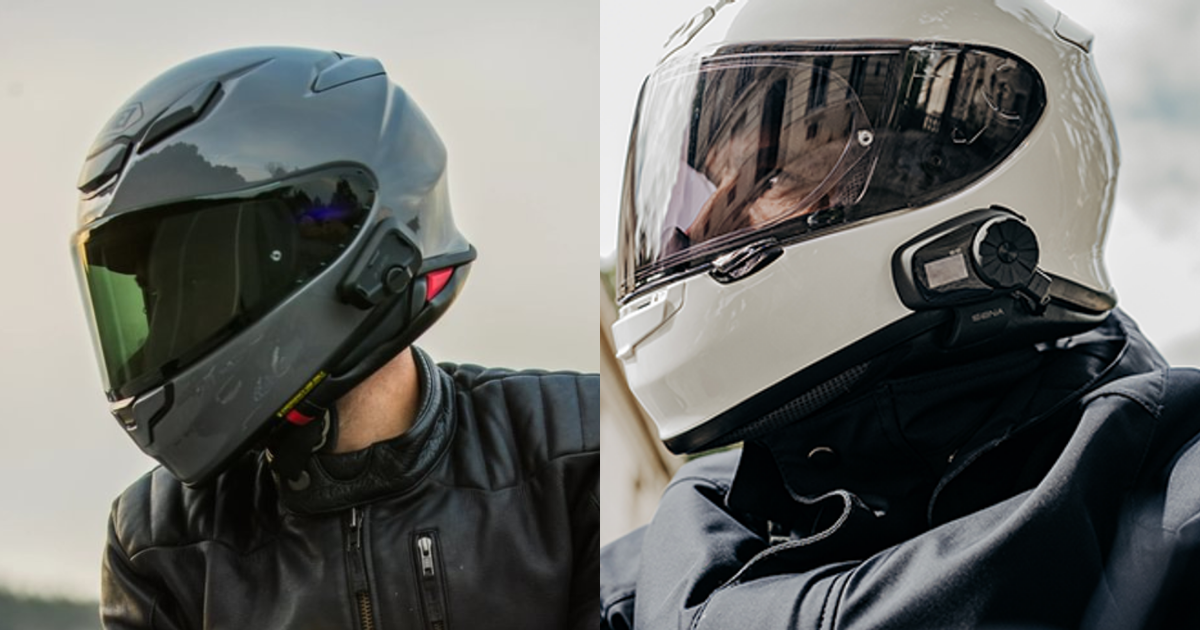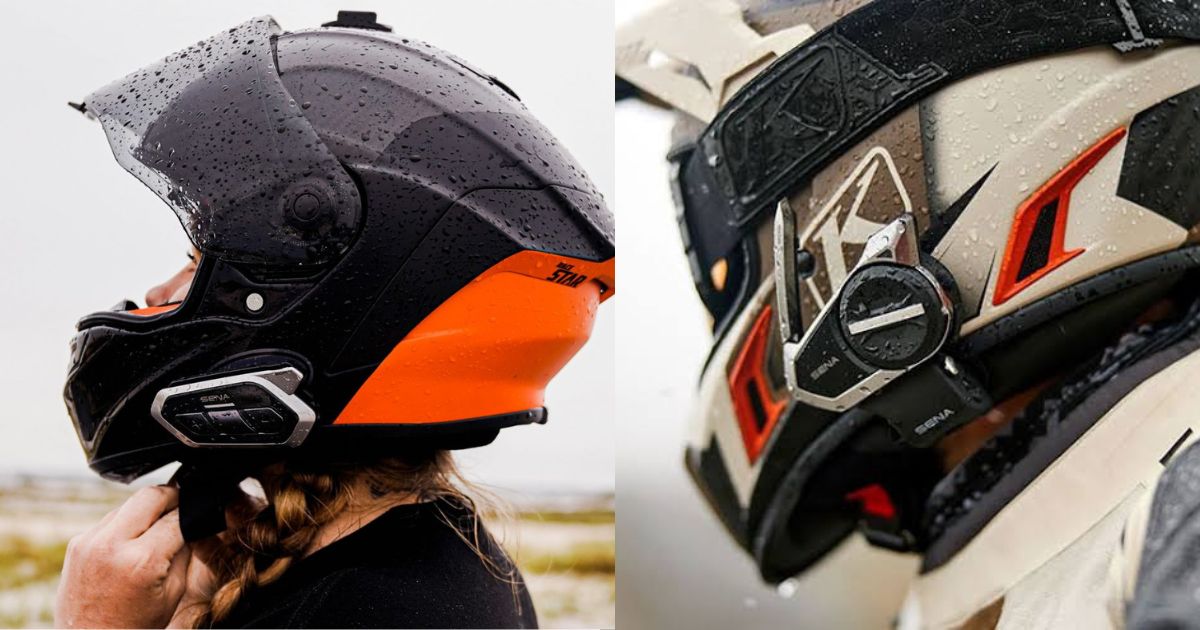
Cardo Spirit HD vs Sena 20S: Which Should You Choose?
left for contents
After logging thousands of miles testing motorcycle intercoms, I’ve learned that the “best” system isn’t always the most expensive one—it’s the one that actually fits how you ride.
The Cardo Spirit HD is a no-nonsense communicator that nails the basics, while the Sena 20S is a feature-rich system built for riders who live in large groups and long tours. Both are solid choices, but they serve completely different types of riders.
Here’s my take on how they perform and which one deserves a spot on your helmet.
$164.95 | $201.75 |
|
|
|
|
- Affordable
- Waterproof
- Music, Intercom, GPS work flawlessly
- Max 2 Intercom Participants
- Short range (600m)
- Excellent sound clarity for music & navigation
- Reliable intercom range with stable connections
- Long battery life—week‑long daily commuting
- Easy glove‑friendly jog dial controls
- Large unit design protrudes visibly on helmet
- Occasional firmware quirks reported by some users
Quick Verdict
- Who should buy Cardo Spirit HD: Riders wanting good audio quality at an accessible price, those needing simple 2-rider communication, and anyone prioritizing a lightweight design with modern charging. This is the perfect option for the solo commuter, the weekend tandem duo, or the rider new to helmet communication. Read my full review after 2 years of regular use here.
- Who should buy Sena 20S: Riders seeking advanced features like 8-way Bluetooth intercom, those needing a larger group capacity, and anyone wanting maximum range and universal Sena compatibility. The 20S is for the serious group rider who can’t afford to have a dropped connection.
Overall, the Spirit HD is a dependable, budget-friendly choice that nails the essentials, while the Sena 20S stands out for riders who want advanced features and reliable group communication.
Understanding Your Communication Needs
Before diving into technical specifications, let’s address the fundamental question: what do you actually need from a motorcycle communication system? The answer varies dramatically based on your riding style, group size, and communication priorities.
Don’t Overthink Your Needs
The reality is that many riders overthink their communication needs. If you primarily ride solo or with one regular partner, investing in advanced Bluetooth network capabilities you’ll rarely use doesn’t make financial sense.
Conversely, if you regularly participate in large group rides or motorcycle tours, basic two-rider systems quickly become limiting.
Check out our Cardo Spirit HD review—budget-friendly, clear audio, and slim build.
Riding Pattern Considerations
- Solo/Partner Riding: If most of your miles involve riding alone or with one consistent partner, basic intercom functionality with reliable phone integration covers your essential needs. Advanced group features become unnecessary overhead. Consider your needs: do you just want to listen to music and get GPS directions, or do you need to talk to a passenger? For the latter, a simple Bluetooth connection is more than sufficient and provides a stable, predictable experience without the complexity of a larger network.
- Occasional Group Rides: For riders who join larger groups occasionally but primarily ride in pairs, systems with Universal Intercom compatibility provide flexibility without requiring premium pricing. You can connect to a friend’s non-Cardo/Sena unit, but you’ll likely lose some advanced features. These riders value versatility but don’t want to overpay for capabilities they’ll only use a few times a year.
- Regular Group Participation: Riders who frequently join organized rides or tour groups benefit from advanced features like a Bluetooth network and larger group capacity, justifying higher investment costs. These riders need a robust system that can handle dynamic group sizes, unexpected drop-outs, and significant distances without requiring manual reconnection. For this type of riding, communication is not a luxury, but a necessity for safety and coordination.
Build Quality and Design Philosophy
Both systems demonstrate solid construction within their respective price categories, though with fundamentally different design approaches that reflect their intended markets.
Cardo Spirit HD: Focused Simplicity
The Spirit HD embodies what I appreciate most about well-designed entry-level gear—it accomplishes its mission without unnecessary complexity. When mounted to a helmet, the lightweight 35g unit disappears into your riding routine until you need it. There’s no bulk, no excessive features to accidentally trigger, just reliable communication when you need it.
What stands out during extended use is how the Spirit HD handles the fundamentals exceptionally well. The build quality feels appropriate for its price point without cheap shortcuts that compromise reliability. The clean button layout makes operation intuitive, even for riders new to motorcycle communication systems.
The IP67 rating provides reliable weather protection without adding bulk. What does this mean in practical terms? It means the unit is completely protected from dust ingress and can be submerged in up to 1 meter of water for 30 minutes.
After testing through rain storms, dusty conditions, and temperature extremes, the unit maintains consistent performance and shows minimal wear. This is exactly what you want from essential riding gear—reliable operation without drama. The materials feel solid and well-molded, giving the impression that this is a device built to last for its intended lifespan.
Sena 20S: Premium Construction
The 20S represents Sena’s robust design philosophy with their signature attention to premium materials and construction details. While slightly heavier at 61g, it feels exceptionally solid in your hands with the kind of build quality that suggests long-term durability.
The construction reflects its higher price point with premium plastics, precise tolerances, and the tactile jog dial interface that Sena users particularly appreciate. Every interaction with the device confirms its quality—from button feedback to mounting system engagement.
The build quality inspires confidence whether you’re planning day rides or extended touring adventures. The unit feels more substantial and ready for the rigors of frequent, long-distance touring. The seals around the charging port and speaker connections are tight and well-fitted, reinforcing the IP67 waterproof rating and providing peace of mind during unexpected downpours.
Check out our Sena 20S review—long-range Bluetooth intercom with solid features.
Mounting Systems: Convenience vs. Security
The mounting approach represents one of the most significant daily-use differences between these systems.
Cardo Spirit HD: Quick-Mount Convenience
The Spirit HD uses Cardo’s quick-mount clamp system that prioritizes ease of use. Mounting and dismounting the unit requires minimal effort and can be accomplished with one hand once you’re familiar with the mechanism. This convenience proves particularly valuable when managing equipment across multiple helmets or troubleshooting group communication issues.
The mounting system provides adequate security for normal riding conditions while maintaining the convenience that makes daily use pleasant rather than tedious.
There’s no complex procedure to remember—just position and secure. This is a huge bonus for commuters or those who frequently move their comms unit between helmets for different riding styles (e.g., a modular for touring and a full-face for sport riding).
While some riders might worry about a unit accidentally coming loose, in my experience, the quick-mount system is secure for all normal riding conditions. It clicks into place with a satisfying, reassuring sound.
Sena 20S: Universal Compatibility
Sena employs their proven universal clamp mount system that emphasizes mechanical security and broad compatibility. The system works reliably across different helmet types and provides that positive mechanical engagement some riders prefer over convenience-focused approaches.
While requiring more deliberate mounting procedures compared to quick-mount systems, the universal clamp approach offers excellent compatibility and rock-solid security once properly installed.
The mechanical engagement gives you confidence that the unit won’t detach even during high-speed riding or in turbulent air. Once you’ve set the screws and secured the clamp, the unit is practically part of the helmet.
This is the kind of security that long-distance tourers or riders who often find themselves on unpaved roads appreciate. It’s a “set it and forget it” system that inspires confidence.
Audio Performance: Clarity Where It Matters
Both systems feature 32mm speakers, but their audio performance reveals important differences in processing and optimization approaches.
Cardo Spirit HD: Essential Audio Done Right
The Spirit HD’s audio performance focuses on clarity and reliability rather than audiophile-level sound quality. Voice communication remains clear at moderate speeds, providing the essential capability most riders need for safe group coordination and phone calls. Music playback serves its intended purpose—background entertainment and podcast listening—without pretending to replace dedicated audio systems. The processing prioritizes speech clarity, which proves most important during riding scenarios where clear communication prevents confusion and maintains group safety.
During highway riding, the audio balance handles GPS announcements, phone calls, and music without constant manual adjustments. Cardo’s automatic volume control adjusts well for speed and ambient noise, while the microphone effectively filters wind and engine noise for clear voice transmission.
The sound profile focuses on mids and highs, making podcasts and vocals easy to understand. While the bass won’t impress audiophiles, it delivers a pleasant riding experience.
This cuts the text roughly in half while preserving all the key information about audio performance, microphone quality, and sound characteristics.
Sena 20S: Premium Audio Processing
The 20S uses Sena’s advanced algorithms and superior noise cancellation for clearer voice communication than the Spirit HD, especially in windy conditions or with loud exhausts. Better automatic volume adjustment and wind filtering maintain conversation clarity across varying conditions.
Music playback offers improved dynamic range compared to entry-level systems, though communication remains the primary focus.
The superior audio processing shines during extended rides where listening fatigue becomes an issue. The 20S maintains comfortable balance without the harsh edge that makes some systems uncomfortable over time. The microphone’s noise-canceling allows clear conversations at highway speeds, while music gets richer bass and clearer instrument separation.
Communication Technology: Range and Capacity
This category reveals the most significant difference between these systems and determines their suitability for different group riding scenarios.
Cardo Spirit HD: Essential Two-Rider Communication
- Range: 600m (0.4 miles) in open terrain
- Group Capacity: 2 riders maximum
- Connection Type: Traditional Bluetooth
- Reconnection: Automatic when riders return within range
The Spirit HD focuses on reliable two-rider communication with automatic reconnection capabilities. The 600m range handles typical riding scenarios where partners maintain reasonable proximity without requiring advanced Bluetooth network overhead. In practical terms, this is about the length of six football fields. The connection is a simple, direct point-to-point link between two riders.
During testing, the Spirit HD maintains consistent communication within its range limitations. Automatic reconnection works reliably when riders separate temporarily, resuming conversation seamlessly when back within range. For riders who primarily communicate with one partner, the Spirit HD provides exactly what’s needed without paying for unused advanced capabilities.
Sena 20S: Advanced Bluetooth Network
- Range: Up to 2km with Bluetooth network
- Group Capacity: 8 riders maximum
- Connection Type: Bluetooth network technology
- Universal Compatibility: Full integration with Sena ecosystem
The 20S’s Bluetooth network allows dynamic group communication where riders can join and leave seamlessly. The extended range and larger capacity suit organized tours and bigger riding groups. The network maintains connections across gaps that would break traditional Bluetooth systems, automatically reconnecting riders when they return to range without manual intervention.
This is a massive advantage over traditional “daisy-chain” systems, which break entirely if a middle rider drops out. With Bluetooth network, each rider acts as a repeater, extending range and allowing conversation to continue even if someone is temporarily separated.
For regular group riders, these advanced capabilities justify the higher investment by enhancing safety and coordination. The 2km range provides much larger cushion for group spread.
Battery Performance: All-Day Reliability
Both systems deliver comparable battery life suitable for full-day rides, though with different charging approaches.
- Cardo Spirit HD: 13 hours of talk time with USB-C charging. The modern charging port provides faster charging speeds and better cable compatibility with current devices. This is a significant convenience bonus, as most modern electronics use USB-C, meaning you can carry one fewer cable on a trip.
- Sena 20S: 13 hours of talk time with micro-USB charging. While using an older charging standard, the system includes power management features that optimize battery life during extended group communication sessions.

Battery performance meets manufacturer specifications across both systems. The Spirit HD’s USB-C charging provides convenience advantages for riders with modern device charging setups, while the 20S’s proven power management handles extended group communication efficiently.
It’s important to note that 13 hours of talk time is based on continuous intercom use. With mixed use of music, GPS, and intermittent communication, both devices can easily last an entire day’s ride.
The Spirit HD’s quick charge feature is also a major plus, allowing for two hours of talk time after only 20 minutes of charging.
Usage Scenarios
Choose the Cardo Spirit HD if:
- You primarily ride solo or with one regular partner: The two-rider limitation becomes irrelevant, and you benefit from the simplified operation and lower cost.
- Budget is a primary consideration: The Spirit HD delivers reliable communication at an accessible price point without compromising essential functionality.
- You prefer straightforward operation: Simple button controls and essential features eliminate complexity that could interfere with riding enjoyment.
- Modern charging convenience matters: USB-C charging integrates better with current device charging setups.
- You’re new to motorcycle communication systems: The learning curve remains minimal while providing a reliable introduction to helmet communication benefits.
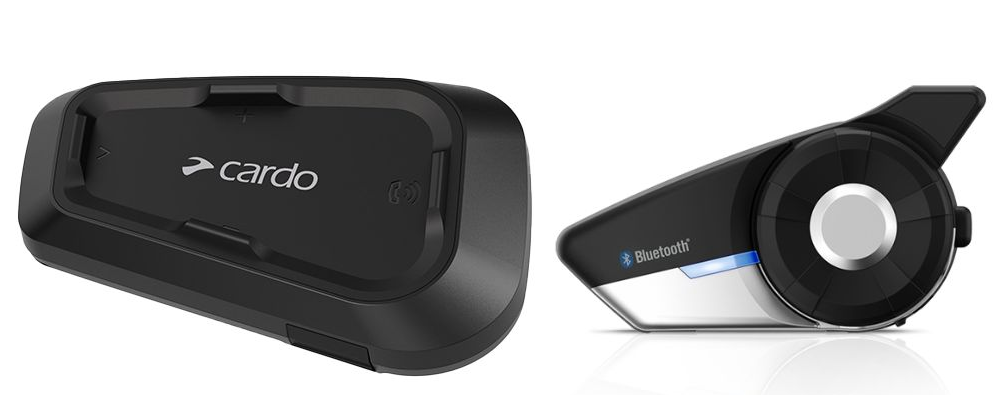
Choose the Sena 20S if:
- You regularly participate in group rides: The 8-rider capacity and Bluetooth network provide genuine benefits for organized riding events and tour groups.
- Advanced features appeal to your riding style: Comprehensive customization options and advanced audio processing enhance the communication experience for serious riders.
- Your riding group uses Sena systems: Universal compatibility within the Sena ecosystem provides seamless integration with existing group equipment.
- Maximum communication range is crucial: The 2km Bluetooth network capability handles challenging terrain and group separation scenarios better than basic systems.
- You can find remaining stock at reasonable prices: Since the 20S has been discontinued, finding remaining inventory at good prices provides access to premium features at a potentially reduced cost.
Learn how to pair Sena and Cardo headsets—tips to avoid pairing headaches.
Love a helmet that only fits a specific comms unit?
HJC, Shoei, Schuberth, Nexx and even Harley all try to force you in to custom-fit comms units that may not fit how you ride. So Tubs Jackson created an adapter to get a factory fit for any comms unit on these otherwise amazing helmets.
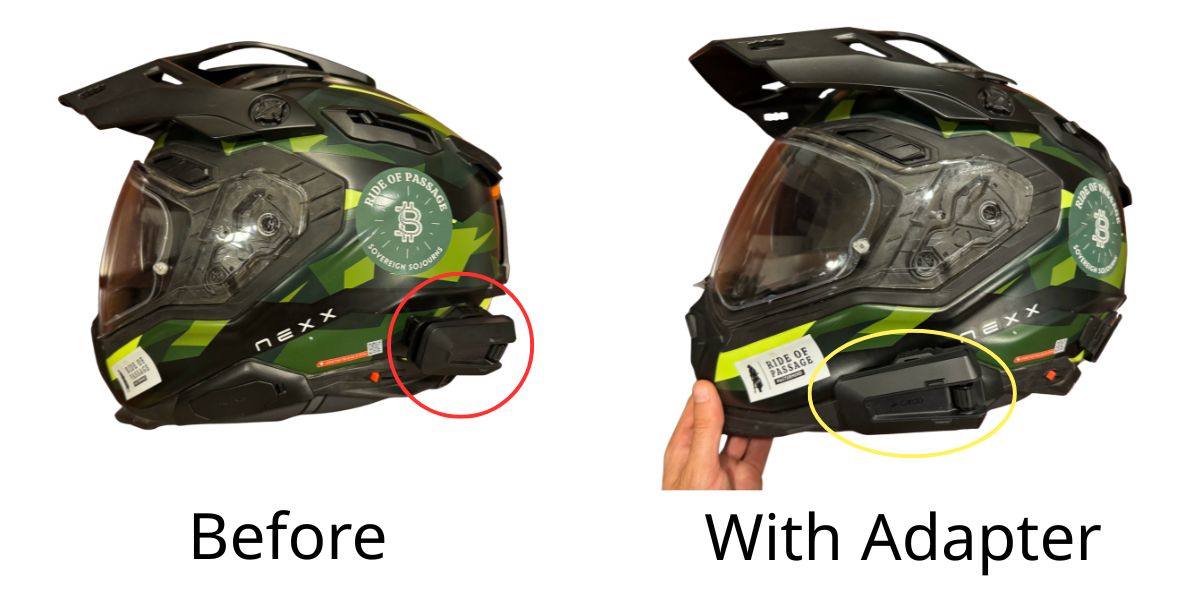
Tubs Jackson is a weird name, I know, but I have their adapter in my Nexx X.WED3 helmet and it’s rock solid. Much nicer than reaching way back to where I had the sticky mount before. I wish I’d thought of this idea.
Tip: Get FREE SHIPPING just by buying here or using code BETTERONTHEROAD at checkout.
Making the Right Investment Decision
Both the Cardo Spirit HD and Sena 20S represent solid investments within their respective market segments. Neither will disappoint you from a performance or reliability standpoint when matched to appropriate usage scenarios. The key insight is that the “best” system is the one that matches your actual riding patterns and communication needs without paying for capabilities you won’t use or lacking features you genuinely need.
$164.95 | $201.75 |
|
|
|
|
- Affordable
- Waterproof
- Music, Intercom, GPS work flawlessly
- Max 2 Intercom Participants
- Short range (600m)
- Excellent sound clarity for music & navigation
- Reliable intercom range with stable connections
- Long battery life—week‑long daily commuting
- Easy glove‑friendly jog dial controls
- Large unit design protrudes visibly on helmet
- Occasional firmware quirks reported by some users
At-a-Glance: Specs & Price
| Features | Cardo Spirit HD | Sena 20S |
| Weight | 45g | 52g |
| Mounting System | Cardo quick-mount clamp | Universal clamp mount |
| Audio | 40mm JBL speakers | 32mm premium speakers |
| Battery Life | 13 hours talk time | 13 hours talk time |
| Intercom Range | 1.6km | 2km |
| Group Capacity | 4 riders | 8 riders |
| Waterproof Rating | IP67 | IP67 |
| Warranty | 2 years | 2 years |
| Street Price (typical) | $164.95 | $201.75 (Discontinued) |
Final Recommendation Framework
- Start with your riding reality: Honestly assess your typical group size, riding frequency, and communication requirements rather than theoretical scenarios. Do you ride solo to work, or do you lead a group of eight friends on cross-country tours every summer?
- Consider your group’s ecosystem: Existing group equipment often influences individual choices more than personal preferences. If everyone you ride with uses a Sena system, a Cardo might not be the best choice, even if you like its features.
- Match features to usage: Pay for advanced capabilities only if you’ll use them regularly enough to justify the investment. Don’t buy a Bluetooth network system if you only ever ride with one other person.
- Factor in long-term value: Both systems provide years of reliable service, making the initial investment decision important for long-term satisfaction. Think about where you want your riding to be in five years.
The choice isn’t about finding the objectively “best” system—it’s about finding the right system for how you actually ride and who you ride with. Both the Spirit HD and 20S excel within their intended use cases, providing reliable communication that enhances safety and enjoyment on the road. Whether you choose essential reliability or advanced capability, you’re investing in better communication that makes every ride safer and more connected.
Related

Best Cardo Communicators for Motorcycle Riders
Find the best Cardo communicator for your rides—compare mesh, Bluetooth, sound, and features to match your budget, group size, and style.

